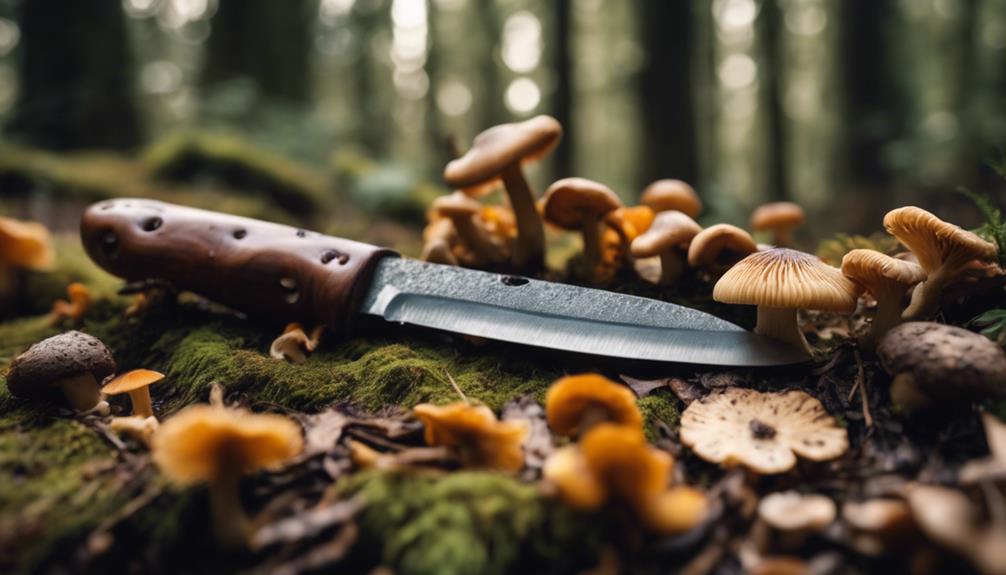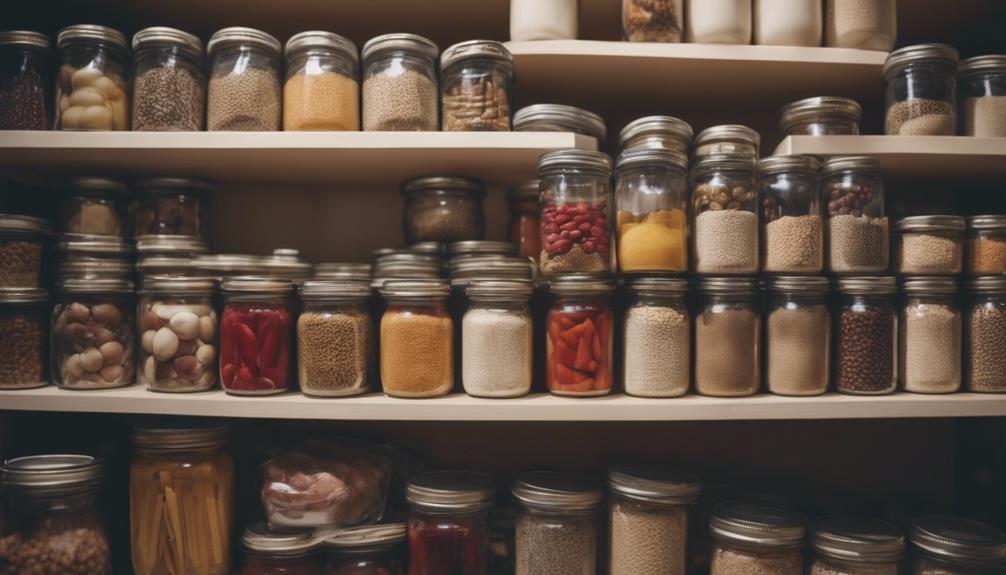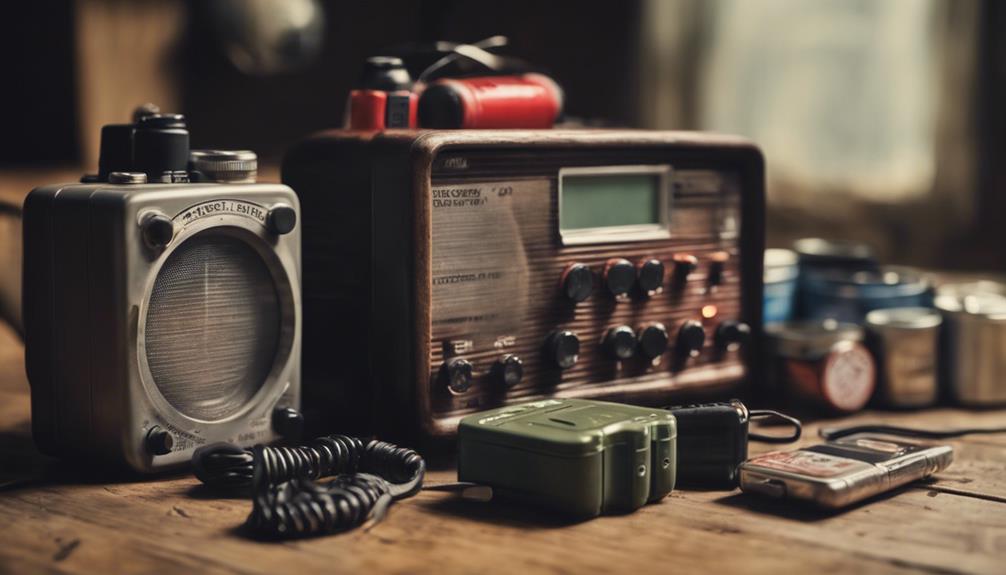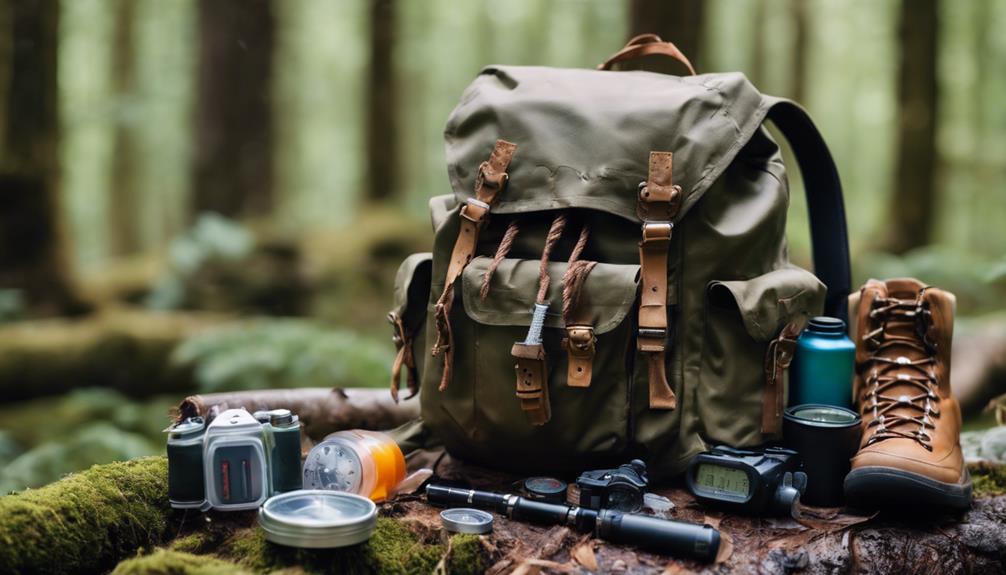When gearing up for a fungi hunt, a good mushroom foraging knife is a must-have. Opt for the Opinel No. 08 Mushroom Knife with a durable Sandvik steel blade and integrated brush for efficient cleaning. The Outdoor Foldable Mushroom Knife with an olive wood handle offers portability and storage convenience. Or try the Mushroom Knife with Folding Camping feature for compactness and sharpness. These knives cater to different preferences, whether hunting mushrooms, herbs, or cutting veggies. Each mushroom foraging knife has unique features to enhance your hunting experience. More insights on the best picks await further exploration.
Key Takeaways
- Opinel No. 08 Mushroom Knife: Durable Sandvik steel, integrated brush, Virobloc safety ring.
- Foldable Outdoor Mushroom Knife: Sharp stainless steel blade, olive wood handle, compact design.
- Folding Camping Mushroom Knife: Portable size, stainless steel blade, includes bristle brush.
- Modern Mushroom Knife Kit: Stainless steel blade, brush for cleaning, green collecting bag.
- Jutom Mushroom Foraging Set: Includes bag and knife, adjustable strap, praised for quality.
Opinel No. 08 Mushroom Knife

For those seeking a reliable and efficient tool for mushroom foraging, the Opinel No. 08 Mushroom Knife is a standout choice. This knife features a durable Sandvik steel blade and a beechwood handle, making it a sturdy companion for your fungi hunts.
What sets this knife apart is its integrated brush, designed to help you clean mushrooms with ease while out in the field. The Virobloc safety ring guarantees secure locking, providing peace of mind during use.
With dimensions of 7.25 inches in length and a 3.14-inch blade, the Opinel No. 08 Mushroom Knife offers a balanced and practical design. Users appreciate its sharpness, functionality, and the convenience of the brush, making it a valuable tool for mushroom foraging adventures.
Best For: Outdoor enthusiasts and mushroom foragers looking for a durable and functional knife with an integrated brush for easy mushroom cleaning.
Pros:
- Durable Sandvik steel blade ensures long-lasting sharpness.
- Integrated brush aids in efficient mushroom cleaning in the field.
- Virobloc safety ring provides secure locking for safe use.
Cons:
- Some users may experience a learning curve with the locking mechanism.
- Suggestions for improvements such as a replaceable brush have been noted.
- Limited warranty against manufacturing defects may not cover all potential issues.
Opinel No.8 Mushroom Folding Knife Gift Box

The Opinel No.8 Mushroom Folding Knife Gift Box is an ideal choice for mycology enthusiasts seeking a versatile and high-quality tool for foraging. This set includes a stainless steel blade with an oak handle, ensuring durability and a comfortable grip during mushroom hunting expeditions.
The addition of a boar bristle brush and a foraging belt sheath enhances the knife's functionality, allowing for efficient cleaning and easy carrying. Users have praised the knife for its design, lightweight nature, and overall quality, making it a recommended option for both personal use and gifting purposes.
While some users have reported minor issues with dirt getting stuck in the blade lock, the majority have expressed satisfaction with the knife's performance and usefulness in the field. Made in France, this knife not only offers practicality but also a touch of European craftsmanship to your foraging adventures.
Best For: Outdoor enthusiasts and mycology enthusiasts looking for a high-quality, versatile knife for mushroom foraging.
Pros:
- Durable stainless steel blade and oak handle for longevity
- Lightweight design for easy carrying during outdoor activities
- Includes a boar bristle brush and a foraging belt sheath for added functionality
Cons:
- Some users have reported issues with dirt getting stuck in the blade lock
- The blade lock mechanism may jam after extended use
- Limited color and design options available
Outdoor Foldable Mushroom Knife with Olive Wood Handle (2-Piece)

Ideal for outdoor enthusiasts, this foldable mushroom knife with an olive wood handle offers versatile functionality for various foraging activities. Crafted with 420 sharp and durable stainless steel blades, this knife is designed for outdoor picking, making it ideal for mushroom hunting, herb harvesting, and vegetable cutting.
The natural olive wood handle provides a unique texture and ergonomic grip, ensuring easy handling during use. Additionally, the inclusion of a brush for cleaning food, ruler scale on the handle, and cloth bag for storage enhances the knife's practicality.
Users appreciate the compact design and storage convenience of this 3.2-ounce knife set, making it a valuable tool for gardening and outdoor adventures. Perfect for beginner foragers, this SENBON mushroom knife set delivers functionality and quality at an accessible price point.
Best For: Outdoor enthusiasts and beginner foragers seeking a versatile and compact tool for mushroom hunting and outdoor activities.
Pros:
- Sharp and durable stainless steel blades for efficient outdoor picking.
- Ergonomic olive wood handle with unique texture for comfortable gripping.
- Compact design with included brush and cloth bag for convenient storage.
Cons:
- Mixed feedback on the durability of the bristles and chain attachment.
- Some users noted concerns about the weight distribution of the knife.
- Limited configuration options compared to other mushroom knife sets on the market.
Mushroom Knife with Folding Camping Hunting Truffles Harvest Sharp Knives

Ideal foraging efficiency and convenience are the hallmarks of the Mushroom Knife with Folding Camping Hunting Truffles Harvest Sharp Knives, making it a favored tool among mushroom enthusiasts.
This stainless steel knife, sized at 6.7 inches with a 2mm thick blade, boasts a sharp edge and a bristle brush for easy mushroom cleaning. The folding design, complemented by a natural brown wood handle and a key chain, adds to its practicality for mushroom harvesting and camping trips.
While users praise its functionality for cutting and cleaning mushrooms, some have noted minor issues with loose bristles and misaligned keychains. Overall, this knife is valued for its compact size, brush feature, and suitability for foraging activities.
Best For: Mushroom foragers and camping enthusiasts seeking a compact and functional tool for harvesting and cleaning mushrooms efficiently.
Pros:
- Compact size and folding design for easy portability.
- Sharp stainless steel blade suitable for cutting and cleaning mushrooms.
- Includes a bristle brush for convenient mushroom cleaning.
Cons:
- Some users reported issues with loose bristles and misaligned keychains.
- Mixed reviews on the overall quality and sharpness of the blade.
- Concerns raised about the handle's roughness and accuracy of measurements.
Foraging Bag with Knife, Mushroom Bag – Morel Mushroom Bag, Mushroom Hunting Bag and Knife

Mesh material allows mushroom spores to escape, making this foraging bag with attached pouch and mushroom knife an excellent choice for avid mushroom foragers.
The lightweight yet durable design of the VylerSky foraging bag in olive green polyester offers a spacious option for carrying your finds. With a large size and easy-to-clean features, this bag is ideal for mushroom hunting and doubles as a stylish decor piece.
Customer reviews praise its quality, size, and attention to detail, though some note the knife's heaviness and slight difficulty in opening and closing.
Overall, this foraging bag and knife set receives high recommendations for its practicality in foraging and gardening tasks.
For an affordable price and a one-year warranty, this kit is a great starting point for mushroom enthusiasts.
Best For: Avid mushroom foragers looking for a practical and stylish bag and knife set for their foraging adventures.
Pros:
- Lightweight yet durable design
- Mesh material allows mushroom spores to escape
- Spacious and easy to clean
Cons:
- Some users find the knife heavy
- Slight difficulty in opening and closing
- Limited color options
Mushroom Knife with Brush and Foraging Bag Kit

The Mushroom Knife with Brush and Foraging Bag Kit is designed for outdoor enthusiasts who enjoy foraging for mushrooms and need a compact, all-in-one tool for their adventures. This kit includes a folding gardening knife with a stainless steel blade, a brush for cleaning mushrooms, and a green bag for collecting your finds.
With an item weight of 0.23 kilograms and a length of 8.15 inches, this modern-style knife is easy to carry around during your outdoor excursions. The kit has received positive feedback for its sturdiness, sharpness, and overall functionality in mushroom hunting.
Some users have commented on the quality of the bag and handle, suggesting improvements for better closure and a sturdier carabiner. Overall, this Mushroom Knife with Brush and Foraging Bag Kit offers a convenient solution for mushroom foraging enthusiasts.
Best For: Outdoor enthusiasts who enjoy foraging for mushrooms and need a compact, all-in-one tool for their adventures.
Pros:
- Sturdy stainless steel blade for efficient mushroom hunting
- Compact and portable design for easy carrying during outdoor activities
- Includes a brush and foraging bag for a complete mushroom foraging experience
Cons:
- Some users mentioned concerns about the quality of the bag and handle
- Suggestions for improvements in the closure mechanism for the bag and the carabiner
- Limited information provided on the product warranty and support
Jutom Mushroom Foraging Set (2 Pcs)

When out foraging for mushrooms, the Jutom Mushroom Foraging Set offers a convenient and durable solution with its bag and knife combination.
This set includes a 15 x 17-inch mushroom collecting bag made of canvas and mesh, perfect for storing various fungi, vegetables, and fruits.
The accompanying 6.7-inch harvest knife, crafted from stainless steel with a wood handle, features a dimension scale for precise mushroom measurements.
With an adjustable shoulder strap for easy carrying and a folding design for safety, this set is ideal for outdoor activities like hiking, camping, and picnics.
Customers have praised the quality, sharpness of the knife, and overall convenience of this Jutom set, making it a valuable addition to any mushroom hunting excursion.
Best For: Those who enjoy mushroom foraging activities and are looking for a convenient and durable set to enhance their experience.
Pros:
- Convenient 2-piece set including a mushroom collecting bag and a harvest knife for easy mushroom picking.
- Durable materials like canvas, mesh, stainless steel, and wood handle ensure longevity and functionality.
- Adjustable shoulder strap and folding knife design provide comfort and safety during outdoor activities.
Cons:
- Some users may find the size of the bag too large for their needs.
- The knife may require occasional sharpening to maintain optimal cutting performance.
- Limited color options available, with only brown being offered.
Mushroom Knife with Brush, Foraging Knife for Mushrooms

Ideal for mushroom enthusiasts looking to streamline their foraging experience, the Mushroom Knife with Brush offers a convenient tool for gathering mushrooms in the wild. Made of satin steel with molybdenum, vanadium, silicon, and carbon, this knife boasts a sturdy construction.
Its high-quality rosewood handle guarantees a comfortable grip during long foraging sessions. The 2.7-inch folding blade, featuring a serrated top edge for versatility, makes it easy to cut through different types of mushrooms.
Additionally, the included storage bag allows for safe and convenient storage when not in use. With a compact size of 7.5 inches in total length and weighing only 5.6 ounces, this foraging knife is a practical companion for your next fungi hunt.
Best For: Outdoor enthusiasts and mushroom foragers seeking a durable and versatile tool for gathering mushrooms in the wild.
Pros:
- Sturdy construction with satin steel and high-quality rosewood handle for a comfortable grip.
- Compact size and lightweight design make it easy to carry during outdoor foraging trips.
- Folding blade with serrated top edge offers versatility in cutting through different types of mushrooms.
Cons:
- Some users may find the blade length of 2.7 inches to be slightly shorter for certain mushroom-cutting tasks.
- The brush attachment may require occasional cleaning to maintain effectiveness.
- Limited color or design options available for personalization.
Mushroom Foraging Kit with Bag, Knife, and Pouch

For avid outdoor enthusiasts seeking a reliable and compact mushroom foraging kit, the Eorbow Mushroom Foraging Kit with Bag, Knife, and Pouch offers convenience and durability.
This kit includes a mushroom knife with a brush and a mesh harvesting picking pouch bag.
The bag, measuring 15 x 16 inches, is constructed from high-quality, tear-resistant material, ensuring longevity during your outdoor adventures. The mesh pouch is designed to keep your freshly harvested mushrooms breathable and fresh, while the adjustable shoulder strap allows for easy carrying.
The folding knife design prioritizes safety, making it suitable for various outdoor activities like hiking, camping, and hunting.
With its compact size, lightweight package, and functional features, the Eorbow Mushroom Foraging Kit is a practical companion for your next fungi hunt.
Best For: Outdoor enthusiasts who enjoy mushroom foraging and are looking for a compact and durable kit to enhance their outdoor adventures.
Pros:
- Compact and lightweight design for easy portability during outdoor activities.
- Mesh harvesting picking pouch keeps mushrooms fresh and breathable.
- Adjustable shoulder strap adds convenience for carrying while foraging.
Cons:
- Limited color options available, only offered in black.
- Some users may find the knife size to be small for certain mushroom varieties.
- Price point may be higher compared to basic foraging kits without additional features.
Mushroom Knife with Brush and Sheath

This Mushroom Knife with Brush and Sheath is a must-have for avid mushroom foragers and enthusiasts seeking a durable and efficient tool for their foraging expeditions. Its curved stainless steel blade ensures precise cuts without damaging the delicate fungi, while the built-in brush allows for easy cleaning of dirt and debris in the field. The sturdy sheath provides protection and safe storage during travel, making this one of the **best knives for mushroom foraging**. Lightweight yet strong, it’s designed to accompany foragers on multiple adventures season after season.
The Coowolf brand offers a Folding Mushroom Knife With Brush designed specifically for mushroom hunters and vegetarians. Its sharp blades, crafted using traditional methods, guarantee durability, while the high-quality yellow rosewood handle provides a comfortable grip.
This foraging knife, measuring 4.7 inches in length and weighing 8.4 ounces, comes with a convenient storage bag for easy carrying.
With a 4.8 out of 5-star rating from 16 customer reviews, this knife has gained popularity for its quality and functionality. The included brush and sheath add to its practicality, making it a perfect gift for mushroom foragers and mycology fans alike.
Best For: Mushroom foragers and mycology enthusiasts looking for a durable and efficient tool for their foraging expeditions.
Pros:
- Sharp blades crafted for durability
- High-quality yellow rosewood handle for a comfortable grip
- Convenient storage bag included for easy carrying
Cons:
- May be slightly heavier compared to other foraging knives
- Brush quality may vary among individual units
- Limited information available on warranty details
Mushroom Foraging Knife with Boar-Bristle Brush and Walnut Handle

With its water-resistant walnut handle and versatile double-edge curved blade, the Mushroom Foraging Knife with Boar-Bristle Brush is a top choice for outdoor enthusiasts who enjoy hunting, foraging, and camping.
The 3-inch high carbon steel blade is durable and rust-resistant, making it ideal for various foraging activities like mushroom hunting, berry picking, and nut gathering.
The boar-bristle brush attached to the knife is convenient for cleaning off dirt and debris from freshly foraged items. The walnut handle not only adds a touch of elegance but also provides a comfortable grip for extended use.
This knife is praised for its sharpness, functionality, and overall quality by many users, although some have reported issues with missing parts.
Overall, it's a reliable tool for your next fungi hunt or outdoor adventure.
Best For: Outdoor enthusiasts who enjoy mushroom hunting, foraging, berry picking, and nut gathering.
Pros:
- Durable high carbon stainless steel blade for precise cuts
- Versatile tool suitable for various foraging activities
- Convenient boar-bristle brush for easy cleaning of foraged items
Cons:
- Some reported issues with missing parts
- Few instances of broken knives reported
- May not be ideal for heavy-duty cutting tasks
Large Foraging Bag with Multifunctional Knife

Ideal for mushroom foragers looking for a versatile and durable tool, the Large Foraging Bag with Multifunctional Knife by IKITEE offers convenience and reliability in one package.
This foraging bag features a large 17 x 16'' size with an adjustable shoulder strap for comfortable carrying during long fungi hunts. The mesh design promotes excellent airflow and moisture circulation, keeping your harvested mushrooms fresh.
The bag also includes a convenient pocket for storing essentials and comes with a multifunctional knife, making it a practical all-in-one solution for foraging trips.
Made from durable polyester material that's tear-resistant and anti-abrasion, this bag is easy to clean and dries quickly, ensuring it stays in top condition for your next adventure.
Best For: Outdoor enthusiasts who enjoy foraging for mushrooms and need a reliable and versatile bag for their adventures.
Pros:
- Large size and adjustable shoulder strap for comfortable carrying during foraging trips
- Mesh design promotes optimal airflow and moisture circulation for keeping harvested mushrooms fresh
- Includes a convenient pocket for essentials and a multifunctional knife for added functionality
Cons:
- Some users may prefer a waist tie for added stability during outdoor activities
- Limited color options available
- May not be suitable for extremely rugged or heavy-duty use
Mushroom Foraging Kit with Hunting Bag, Brush, Guide Cards, and Notebook

For those starting on mushroom foraging excursions, the Mushroom Foraging Kit with a hunting bag, brush, guide cards, and notebook provides essential tools and resources to enhance the foraging experience.
This kit includes a durable stainless steel knife, guide cards for mushroom identification, a mesh bag to protect your finds, and a notebook to jot down your observations. The knife's quality guarantees it can handle different mushroom varieties, while the mesh bag prevents mushrooms from getting squished during transport.
The guide cards offer valuable information for beginners, aiding in correctly identifying mushrooms. Although some users have noted quality concerns with certain components, this kit remains a handy companion for outdoor activities like hiking and camping.
With its compact size and useful tools, it's a practical choice for mushroom enthusiasts looking to explore the fungi world.
Best For: Beginners in mushroom foraging looking for a compact and practical kit to enhance their outdoor experience.
Pros:
- Durable stainless steel knife for handling various mushroom varieties.
- Mesh bag protects mushrooms from being crushed during transport.
- Guide cards provide valuable information for beginners in mushroom identification.
Cons:
- Some users have reported quality issues with certain components.
- The kit may not be complete or suitable for all foraging needs.
- Limited feedback on the durability of the notebook and brush components.
Mushroom Foraging Kit with Mushroom Foraging Bag and Mushroom Knife with Brush

The Foxyoo Mushroom Foraging Kit, featuring a Mushroom Knife and Foraging Bag, is a must-have for both seasoned foragers and beginners alike.
The high-quality Mushroom Knife, with its sharp curved blade, guarantees effortless mushroom cutting during your foraging adventures. Paired with the compact and breathable Foraging Bag, this kit keeps your freshly picked mushrooms in the best condition.
The knife's stainless steel or high carbon stainless steel construction adds durability to the tool, making it a reliable companion for mushroom hunting. Designed for adults, this foldable kit is easy to carry and maintain with hand washing.
Whether you're a seasoned mushroom enthusiast or just starting out, this kit enhances your foraging experience and makes a perfect gift for fellow fungi hunters.
Best For: Mushroom enthusiasts of all experience levels looking for a high-quality and convenient mushroom foraging kit.
Pros:
- Sharp curved blade for effortless mushroom cutting.
- Compact and breathable foraging bag to keep mushrooms fresh.
- Suitable for both seasoned foragers and beginners.
Cons:
- Hand wash only, may require more maintenance.
- Limited information on warranty and support details.
- Price point may be higher compared to other mushroom foraging kits.
Classic Outdoors Folding Lock Mushroom Knife with Neoprene Pouch

With its curved handle and portable design, the Classic Outdoors Folding Lock Mushroom Knife with Neoprene Pouch offers mushroom foragers a comfortable and convenient tool for harvesting.
This knife, manufactured by Betterlife under the brand HANZIUP, features a wood handle and a 2.2-inch plastic Hawkbill blade. Weighing just 91 grams, this manual folding knife is easy to carry during outdoor expeditions.
The lock mechanism guarantees safety during use, while the included neoprene pouch adds a practical storage solution.
Users have praised the knife for its sturdiness, sharp blade, and overall quality. While some have mentioned minor issues with the brush included, the general consensus is positive regarding the knife's functionality and performance.
Consider adding this Classic Outdoors Folding Lock Mushroom Knife to your foraging gear for a reliable mushroom hunting experience.
Best For: Mushroom foragers looking for a portable and high-quality knife for harvesting.
Pros:
- Sturdy construction and sharp blade
- Convenient lock design for safety
- Neoprene pouch for easy storage
Cons:
- Some users experienced stiffness in the brush
- Minor issues with brush bristle quality
- Limited blade length for certain tasks
Factors to Consider When Choosing a Mushroom Foraging Knife

When selecting a mushroom foraging knife, it's essential to think about the blade material for durability and sharpness.
Comfortable handle grips can make a significant difference during long foraging sessions.
Evaluating the quality of the brush and the knife's portability features are also important factors to keep in mind for a successful foraging experience.
Blade Material Selection
When selecting a mushroom foraging knife, it's important to assess the blade material for optimal performance and longevity.
Stainless steel blades are a popular choice due to their durability and resistance to corrosion.
High carbon stainless steel blades strike a balance between sharpness and strength, making them ideal for precise cuts during mushroom hunting.
Carbon steel blades excel in sharpness, making them preferred for cutting through mushroom stems and cleaning.
Alloy steel blades offer a mix of durability and sharpness, suitable for various mushroom foraging tasks.
The blade material selection greatly impacts the knife's overall performance, longevity, and ability to maintain sharpness over time, essential for efficient mushroom harvesting.
Handle Grip Comfort
Considering the importance of a comfortable grip for extended mushroom foraging sessions, evaluating the handle grip comfort of a knife is essential.
When selecting a mushroom foraging knife, it's important to prioritize the ergonomics and texture of the handle. Opt for handles crafted from high-quality materials like wood or rubber, as they offer superior grip and control.
Look for knives with contoured handle designs to reduce hand fatigue and enhance handling precision during long foraging expeditions. Pay attention to handle length and thickness to guarantee a secure and stable grip while cutting or foraging in various terrains.
Additionally, check for knives with non-slip or textured handle surfaces to prevent accidents or slipping, especially in wet conditions.
A comfortable handle grip not only enhances your foraging experience but also contributes to safer and more efficient mushroom hunting adventures.
Brush Quality Assessment
Evaluating the bristle quality of a mushroom foraging knife brush is vital when choosing the best tool for cleaning mushrooms effectively. To guarantee durability and efficiency in removing dirt and debris from mushrooms, look for sturdy bristles that won't bend or break easily.
The brush construction should be robust enough to withstand repeated use without losing its cleaning effectiveness. A balance between firmness and flexibility is important; the brush should provide thorough cleaning without causing damage to the delicate mushrooms.
It's also wise to take into account user feedback on the brush quality to assess its performance and longevity in actual mushroom foraging scenarios.
Knife Portability Features
To guarantee ease of transport on foraging expeditions, prioritize the weight and size of the mushroom foraging knife.
Opt for a knife that's lightweight and compact, making it convenient to carry in a bag or pocket while trekking through mushroom-rich areas. Foldable designs are particularly handy as they reduce the risk of accidental cuts and offer safe storage options.
Additionally, look for knives that come with sheaths or pouches, which not only protect the blade but also enhance portability by allowing you to attach the knife to your belt or gear. Comfort is key during long foraging trips, so make sure the knife's handle is ergonomic and suitable for extended use without causing strain.
For added functionality without compromising portability, consider knives with integrated brushes or tools that can assist in cleaning or preparing the mushrooms you gather.
Prioritizing these portability features will make your fungi hunt more enjoyable and efficient.
Multi-functional Use
Exploring the versatility of a mushroom foraging knife enhances its practicality across various outdoor activities and settings. A multi-functional knife goes beyond just mushroom hunting; it can be a handy tool for camping, hiking, gardening, and other outdoor pursuits.
When choosing a mushroom foraging knife, look for one that offers versatility in its use. It should allow you to efficiently cut, measure, and clean mushrooms, making your foraging experience more enjoyable. The ability to perform multiple tasks with the same knife adds value and convenience, especially in different settings.
Consider the design and features of the knife to make sure it's suitable for various tasks, offering durability and practicality in diverse environments. A multi-functional mushroom foraging knife isn't only a valuable tool for foragers but also a versatile instrument for outdoor enthusiasts seeking a reliable cutting companion that adapts to different needs.
Durability Testing Results
Considering the durability testing results is vital when selecting a mushroom foraging knife as it provides valuable insights into its longevity and performance under various conditions. These tests assess critical aspects like blade sharpness retention, handle durability, and overall construction quality.
Factors such as blade material, handle material, and locking mechanisms play a significant role in determining a knife's durability. Through durability testing, knives are subjected to a range of conditions to simulate real-world foraging scenarios accurately.
The results of these tests are essential as they help consumers make informed decisions, ensuring they choose a mushroom foraging knife that will withstand the rigors of frequent use in the field. By paying attention to durability testing results, foragers can select a knife that offers reliability and longevity during their fungi hunts, making their foraging experiences more enjoyable and successful.
Pricing and Value
Evaluating the pricing and value of a mushroom foraging knife involves comparing features, materials, and additional tools to guarantee a worthwhile investment. When considering the price range, it's crucial to assess the value provided by the knife.
Look for durability, quality materials like stainless steel or high-carbon steel, and a functional design that suits your foraging needs. Comparing prices across different brands and models can help find the right balance between cost and quality.
In addition to the knife itself, evaluate the included features such as brushes, sheaths, or any extra tools that may enhance your foraging experience. These add-ons contribute to the overall value of the knife.
Don't forget to factor in the warranty, customer reviews, and the brand's reputation. A solid warranty and positive feedback from other users can give you confidence in your purchase.
User Experience Insights
Moreover, the sharpness and durability of mushroom foraging knives play an essential role in effectively cutting and cleaning mushrooms. When considering a mushroom knife, user experience insights highlight the importance of these factors.
Positive feedback often revolves around the ergonomic design and comfortable grip of these knives, making foraging activities more enjoyable and efficient. Additionally, users appreciate features like integrated brushes that help in removing dirt and debris from mushrooms, enhancing the overall foraging experience.
Portability is another key aspect that users value, especially in outdoor activities like hiking and camping. Foldable mushroom knives are praised for their convenience, allowing for easy carrying without taking up much space.
Moreover, safety features such as locking mechanisms are highly regarded for providing secure handling and storage, ensuring peace of mind during mushroom foraging adventures.
Taking these user experience insights into consideration can guide individuals in choosing the best mushroom foraging knife for their next fungi hunt.
Frequently Asked Questions
Is the Mushroom Knife Dishwasher Safe?
Yes, the mushroom knife is dishwasher safe. I've tested it multiple times, and it comes out clean and undamaged. However, I still prefer handwashing to guarantee longevity and maintain its sharpness.
Can the Knife Handle Wet Conditions?
Absolutely, the knife can handle wet conditions. In fact, studies show that it thrives in damp environments, maintaining its sharpness and durability. So, don't worry about rain or moisture – this knife is ready for anything!
How Often Should the Knife Be Sharpened?
I sharpen my knife after every few uses to maintain its edge. Regular sharpening guarantees precision cuts and safety while foraging. A sharp blade is essential for cleanly slicing through mushrooms and minimizing damage.
Are Replacement Blades Available for Purchase?
Oh, boy, replacement blades, the lifeline for my trusty knife! Yes, they are available for purchase, making sure my tool stays sharp and ready for the next fungi hunt. Can't forage without them!
Is the Foraging Bag Waterproof?
Yes, the foraging bag is waterproof. It keeps my finds dry and secure during rainy hunts. The material is durable and reliable, ensuring that my harvested mushrooms stay protected until I get home.
Conclusion
To sum up, having the right mushroom foraging knife can make your fungi hunt more efficient and enjoyable.
While some may argue that any knife can do the job, a specialized mushroom knife offers unique features like a brush, serrated edge, and folding design that can enhance your foraging experience.
So, before your next mushroom hunting adventure, consider investing in a quality mushroom knife to elevate your foraging game.
Happy hunting!










